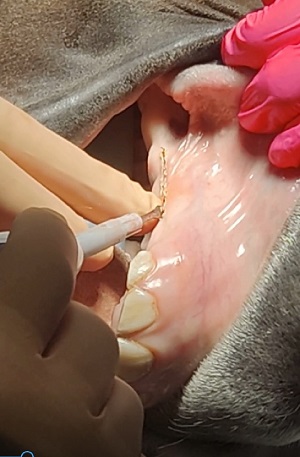Harmonic Scalpel’s Help to Horses
Clinical Connections – Summer 2025
Andy Fiske-Jackson, Deputy Head of RVC Equine and Associate Professor in Equine Surgery
RVC Equine has a new harmonic scalpel, which has been helping a range of referred equine patients, including several horses with melanomas.
The technology has applications beyond equine oncology though and was, for example, used in the case of a horse with guttural pouch mycosis, as discussed below.
The harmonic scalpel's ultrasonic vibrations create a precise and controlled incision, whilst providing haemostasis, which reduces the risk of excessive tissue damage compared to other approaches, such as laser or electrosurgery.

Enhancing equine oncology efficacy
The RVC has developed increasing expertise in equine oncology over recent years and the acquisition of a harmonic scalpel is helping us improve our treatment of melanomas and other tumours. We are one of very few equine hospitals in the UK that has access to a harmonic scalpel for tumour removal.
Up to 80% of grey horses over 15 years old have a melanoma. They can occur anywhere but have a predilection for certain areas, including the perianal and parotid region.
Historically, they were commonly left untreated as they are slow growing and excision can be associated with problems due to their location. Removal using the currently preferred method of diode laser frequently results in numerous complications, including pain during defaecation and resultant rectal impactions. Likewise, sharp dissection can be hampered by bleeding and the proximity to delicate structures such as the parotid salivary gland.
However, even with their slow growth, leaving melanomas untreated can result eventually in unacceptable morbidities arising, for example obstruction of the anus, which can lead to euthanasia.
In recent years, the Equine Referral Hospital has successfully treated melanomas through innovative therapy, including tumour specific electroporation (TSE) and excisions.
The addition of the harmonic scalpel to our capabilities has a significant positive impact on welfare. The reduced risk of complications makes the procedure more attractive to owners of horses with melanomas – as well as enabling a variety of other procedures to be performed more safely, and with less postoperative pain.

The harmonic scalpel was funded by the Prowting Charitable Foundation, via the RVC’s charity the Animal Care Trust.
Guttural pouch mycosis case – Angel
Angel was referred to the Equine Referral Hospital towards the end of March and stayed for six days. She had epistaxis originating in the right guttural pouch.
Upon presentation Angel was tachycardic but other physical parameters were within normal limits.
Within the right guttural pouch a large blood clot was evident, preventing visualisation of most of the pouch. On the medial aspect of the guttural pouch, the edge of a fungal plaque was present in the region of the internal carotid artery. The left guttural pouch was normal.
Angel underwent balloon catheterisation of the right internal carotid artery, under general anaesthesia. The harmonic scalpel allowed a precise dissection to the internal carotid artery, providing haemostasis – thereby improving visualisation within the surgical field. The ability to cut whilst cauterising also improved the speed of the procedure.
In the day prior to and the day of discharge, upper airway endoscopy was performed. This revealed that the blood clot had resolved, allowing the extent of the plaque to be visualised. A firm plaque was evident adherent to the internal carotid artery. This extended over the stylohyoid bone to the region of the external carotid artery. On both occasions the site was treated with topical enilconazole.
Angel returned to the hospital a week later for removal of the balloon catheter. She was bright and alert, with all vital parameters within normal limits and the harmonic scalpel incision was well healed.
Endoscopy of the right guttural pouch found the fungal plaques to be darkened and regressing. Topical treatment with dilute enilconazole was repeated. The staples were removed, and a small incision was made for the balloon catheter’s removal. No epistaxis or bleeding from the site was observed.
Angel has recovered completely; the plaque has resolved, and she is back in full work. There has been no repeat of the epistaxis and no complications following the procedure.
